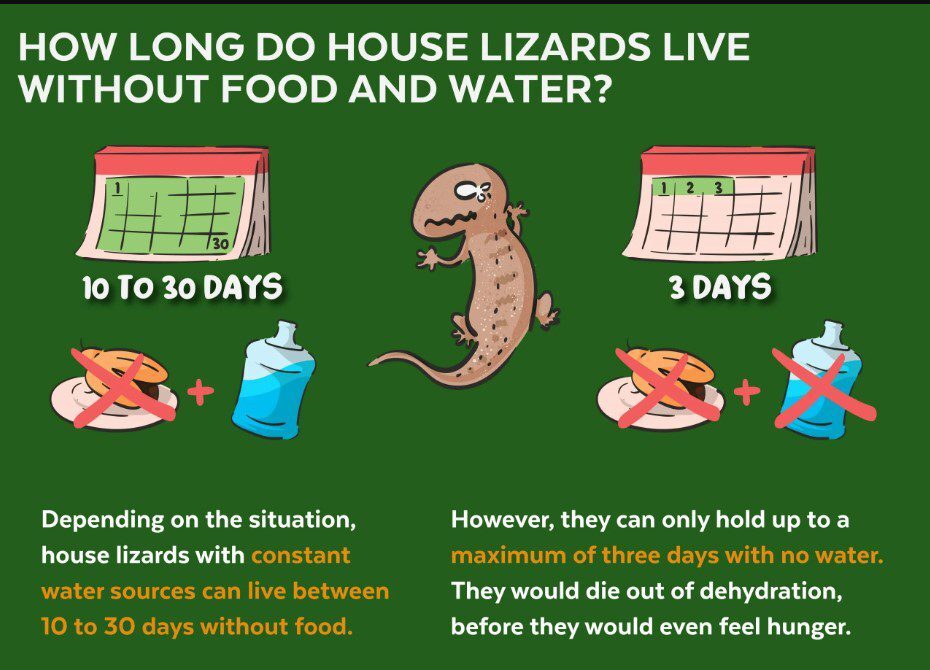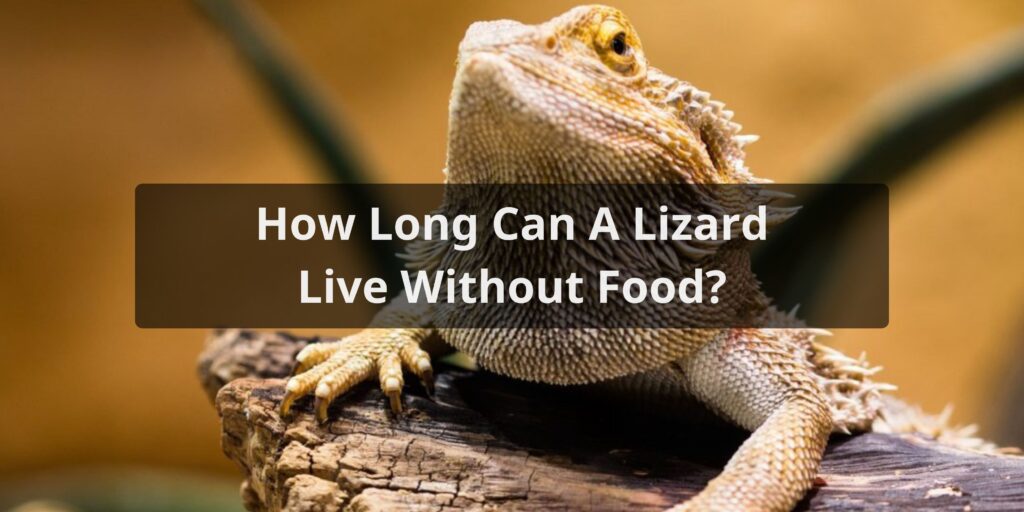Lizards are fascinating creatures that have unique abilities to survive in a variety of environments. One of their most impressive traits is the ability to go extended periods of time without food. But just how long can a lizard live without eating? The answer depends on a few key factors.
The Type of Lizard Matters

- Different lizard species have evolved diverse strategies for coping with lack of food. Some types of lizards can survive longer without eating than others.
- For example, the gila monster (Heloderma suspectum) can live for months without food thanks to its slow metabolism and large fat stores in its tail. It’s one of the longest-surviving lizards when food is scarce.
- Smaller lizards like anoles burn calories faster and cannot last nearly as long without eating. Anoles may only survive a week or two during food shortages before their health becomes compromised.
- Desert-dwelling lizards also tend to have physiological and behavioral adaptations for dealing with lack of food. Species like the zebra-tailed lizard (Callisaurus draconoides) can minimize energy use and rely on stored fat when prey is limited in their harsh environment.
Body Condition Affects Survival Time
- The health of a lizard before food is restricted can greatly influence how long it survives without eating.
- A plump, well-fed lizard with substantial energy reserves can endure significantly longer compared to a thin lizard that’s already metabolically stressed. Fat stores provide the key energy source when food is not available.
- For most small lizards, having adequate body fat to burn can make the difference between surviving weeks versus just days. This demonstrates why maintaining good body condition is so vital for lizards’ ability to cope when prey abundance declines.
Temperature Impacts Metabolic Rate
- Ambient temperature significantly affects lizard metabolism, which directly impacts survival time when food is scarce.
- Lower body temperatures correlate with slower metabolism in lizards. Cool conditions thereby reduce their energy requirements and allow fat reserves to last longer.
- For many species, colder seasons like winter may enable surviving longer without food simply due to lower temperatures decreasing metabolic rate. Warm periods with high temperatures speed metabolism and shorten potential survival time.
- This thermoregulatory strategy exemplifies how lizards skillfully utilize environmental conditions to their advantage when food is limited.
Periodic Feedings Can Prolong Life
- Complete lack of food is not sustainable forever, but periodic tiny meals can prolong how long a lizard survives.
- When prey is extremely scarce, lizards may tap their fat stores during long fasts. But eventually, some minimal nutrition is needed to re-supply electrolytes, vitamins, and minerals.
- Infrequent, tiny prey items like one insect per week can make an important difference in staving off malnutrition. This lower-calorie input extends how long a lizard’s fat supply supports basic body functions.
- So while total starvation ultimately leads to death, strategic periodic feedings during lean times may significantly extend how long a lizard perseveres up to several months.
Individual Health Affects Outcomes
- The exact length of time a lizard can survive without food can vary substantially based on its individual health status.
- Age, injuries, parasites, and diseases may compromise a lizard’s overall condition. Lizards facing these challenges often have weaker resilience and may succumb more quickly to lack of food.
- Conversely, an adult lizard in its prime with robust health may endure much longer unfed periods before its condition starts deteriorating. Good health equates to better survival odds.
- Evaluating each lizard’s unique situation is necessary to estimate time to starvation based on overall vitality. Underlying health issues shorten survival, while prime condition lengthens it.
Conclusion
In summary, how long can a lizard live without food depends on several key factors. Lizard species, body condition, temperature, periodic feedings, and individual health all impact potential survival time. While exact estimates vary, most small lizards can persist for weeks without food by burning fat stores. Larger lizards like Gila monsters can survive for months thanks to their slower metabolism. But eventually a minimal nutrient supply is required to maintain life. Understanding the diverse strategies lizards have evolved to cope with food scarcity provides fascinating insight into their resilience and adaptability.
FAQs About How Long Can A Lizard Live Without Food
How long can a healthy adult lizard survive without food?
The duration varies, but most healthy adult lizards can survive without food for about 2 to 4 weeks. This timeframe depends on factors such as species, size, health, and environmental conditions.
Are there variations in survival time based on lizard species?
Yes, different species have varying abilities to endure food scarcity. Some species are adapted to tolerate longer periods without food, while others require more frequent feeding due to their metabolic rates and specific needs.
What factors can influence a lizard’s ability to survive without food?
Metabolic rate, body size, health status, and environmental conditions are major factors. Lizards with slower metabolisms tend to require less food, while larger lizards may store more energy reserves.
Do younger lizards have a different tolerance for food deprivation?
Yes, younger lizards typically have higher metabolic rates and faster growth rates. They need more frequent feeding and may have a lower tolerance for extended periods without food compared to adults.
How does temperature impact a lizard’s ability to go without food?
Warmer temperatures can increase metabolic rates, causing lizards to burn energy more quickly. In colder conditions, their metabolism slows, allowing them to conserve energy and survive longer without food.
Can lizards survive longer without food during hibernation or brumation?
Yes, lizards can survive for extended periods without food during hibernation (cold-blooded animals’ winter dormancy). Their slowed metabolism and reduced activity levels help conserve energy reserves.
What signs indicate that a lizard is suffering from hunger stress?
Visible signs include weight loss, lethargy, weakness, and changes in behavior. Lizards may become more reclusive or inactive as they conserve energy. It’s essential to address hunger stress promptly.
Can lizards find water sources in their habitat when they’re not eating?
Yes, many lizards can obtain water from their environment even when they’re not actively eating. They might drink dew, lick moisture from surfaces, or absorb water through their skin.
Are there any potential health risks if a lizard goes without food for too long?
Extended food deprivation can lead to malnutrition, weakened immune systems, and metabolic imbalances. Prolonged hunger stress can compromise a lizard’s overall health and make it more susceptible to diseases.
How do lizards store energy and nutrients to sustain them during periods without food?
Lizards store energy as fat deposits, primarily in their tails and bodies. These reserves provide a source of nutrients and energy during periods of food scarcity. However, relying solely on these reserves for extended periods can have health consequences.



